Hypecoum spp.—Chemistry and Biological Activity of Alkaloids
Abstract
1. Introduction
2. Botany
3. Ethnopharmacological Relevance
4. Chemistry of Hypecoum Alkaloids
4.1. Protopine Alkaloids
4.2. Protoberberine Alkaloids
4.3. Benzophenantridine Alkaloids
4.4. Aporphine Alkaloids
4.5. Simple Isoquinoline Alkaloids
4.6. Secoberbine Alkaloids
4.7. Spirobenzylisoquinoline Alkaloids
4.8. Other Alkaloids
5. Biosynthesis and Chemotaxonomical Relevance of Isoquinoline Alkaloids
6. Biological Activities
6.1. Anti-Inflammatory Activity
6.2. Anticancer Activitiy
6.3. Antibacterial and Antifungal Activity
6.4. Antiviral Activity
6.5. Analgesic Effect
6.6. Anti-Lipase Activity
6.7. Antioxidant Activity
6.8. Hepatoprotective Effect
6.9. Anti-Hyperglycemic Activity
6.10. Insecticidal Activity
7. Conclusions and Future Perspectives
Author Contributions
Funding
Institutional Review Board Statement
Informed Consent Statement
Data Availability Statement
Conflicts of Interest
References
- WFO. World Flora Online. 2023. Available online: http://www.worldfloraonline.org/search?query=Hypecoum (accessed on 17 July 2023).
- Zhang, R.F.; Zha, S.; Yin, X.; Bai, R.F.; Li, Y.; Tu, P.F.; Chai, X.Y. Phytochemical and pharmacological progress on Tibetan medicine Hypecoi Erecti Herba and plants of Hypecoum L. Chin. Tradit. Herb. Drugs 2016, 47, 1217–1224. [Google Scholar] [CrossRef]
- Oyuntsetseg, N.; Khasnatinov, M.A.; Molor-Erdene, P.; Oyunbileg, J.; Liapunov, A.V.; Danchinova, G.A.; Oldokh, S.; Baigalmaa, J.; Chimedragchaa, C. Evaluation of direct antiviral activity of the Deva-5 herb formulation and extracts of five Asian plants against influenza A virus H3N8. BMC Complement. Altern. Med. 2014, 14, 235. [Google Scholar] [CrossRef] [PubMed]
- Song, P.; Xia, J.; Rezeng, C.; Tong, L.; Tang, W. Traditional, complementary, and alternative medicine: Focusing on research into traditional Tibetan medicine in China. BioSci. Trends 2016, 10, 163–170. [Google Scholar] [CrossRef] [PubMed][Green Version]
- Zhou, J.; Xie, G.; Yan, X. Encyclopedia of Traditional Chinese Medicines—Molecular Structures, Pharmacological Activities, Natural Sources and Applications; Springer: Berlin/Heidelberg, Germany, 2011; Volume 5, p. 468. [Google Scholar]
- Hao, D.; Xu, L.; Zheng, Y.; Lyu, H.; Xiao, P. Mining therapeutic efficacy from treasure chest of biodiversity and chemodiversity: Pharmacophylogeny of Ranunculales medicinal plants. Chin. J. Integr. Med. 2022, 28, 1111–1126. [Google Scholar] [CrossRef]
- Philipov, S.; Istatkova, R.; Denkova, P.; Dangaa, S.; Samdan, J.; Krosnova, M.; Munkh-Amgalan, C. Alkaloids from Mongolian species Hypecoum lactiflorum Kar. et Kir. Pazij. Nat. Prod. Res. 2009, 23, 982–987. [Google Scholar] [CrossRef]
- Gözler, T.; Önür, M.A.; Minard, R.D.; Shamma, M. (−)-Corydalisol: A new secoberbine alkaloid. J. Nat. Prod. 1983, 46, 414–416. [Google Scholar] [CrossRef]
- Pabuççuoglu, V.; Arar, G.; Gözler, T.; Freyer, A.J.; Shamma, M. Nitrotyrasanguinarine: An unusual nitrated benzophenanthridine alkaloid from Hypecoum species. J. Nat. Prod. 1989, 52, 716–719. [Google Scholar] [CrossRef]
- Zhang, G.; Rücker, G.; Breitmaier, E.; Mayer, R. Alkaloids from Hypecoum leptocarpum. Phytochemistry 1995, 40, 1813–1816. [Google Scholar] [CrossRef]
- Saad, H.E.A. (±)-8-Oxohypecorinine from Hypecoum procumbens var. glaucescens. Phytochemistry 1995, 38, 1049–1051. [Google Scholar] [CrossRef]
- Zhou, Y.; Zhang, G.; Li, B. Five alkaloids from Hypecoum leptocarpum. Phytochemistry 1999, 50, 339–343. [Google Scholar] [CrossRef]
- Su, Y.F.; Li, S.K.; Li, N.; Chen, L.L.; Zhang, J.W.; Wang, J.R. Seven alkaloids and their antibacterial activity from Hypecoum erectum L. J. Med. Plants Res. 2011, 5, 5428–5432. [Google Scholar] [CrossRef]
- Yakhontova, L.D.; Komarova, M.N.; Perel’son, M.E.; Blinova, K.F.; Tolkachev, O.N. Alkaloids of Hypecoum erectum structure of hypecorine and hypecorinine. Chem. Nat. Comp. 1972, 8, 592–595. [Google Scholar] [CrossRef]
- Önür, M.A.; Abu Zarga, M.H.; Gözler, T. Hypecumine: A new 3-arylisoquinoline Hypecoum procumbens. Planta Med. 1986, 52, 70–71. [Google Scholar] [CrossRef]
- Shamma, M.; Rothenberg, A.S.; Jayatilak, G.S.; Hussain, S.F. A new group of isoquinoline alkaloids: The secoberbines. Tetrahedron 1978, 34, 635–640. [Google Scholar] [CrossRef]
- Doncheva, T.; Kostova, N.; Vutov, V.; Aneva, I.; Philipov, S. Comparative study of the alkaloid composition in some Bulgarian species of genus Hypecoum. Compt. Rend. Acad. Bulg. Sci. 2019, 72, 727–731. [Google Scholar] [CrossRef]
- Doncheva, T.; Kostova, N.; Valcheva, V.; Toshkovska, R.; Vutov, V.; Philipov, S. Hypepontine, a new quaternary alkaloid with antimicrobial properties. Nat. Prod. Res. 2020, 34, 668–674. [Google Scholar] [CrossRef]
- Yuan, H.L.; Zhao, Y.L.; Qin, X.J.; Liu, Y.P.; Yang, X.W.; Luo, X.D. Diverse isoquinolines with anti-inflammatory and analgesic bioactivities from Hypecoum erectum. J. Ethnopharmacol. 2021, 270, 113811. [Google Scholar] [CrossRef]
- Xu, N.; Bao, W.; Xin, J.; Xiao, H.; Yu, J.; Xu, L. A new 1, 3-Benzodioxole compound from Hypecoum erectum and its antioxidant activity. Molecules 2022, 27, 6657. [Google Scholar] [CrossRef]
- Zhang, Q.; Ma, T.; Hu, N.; Ding, C.; Liang, Y.; Li, W.; Suo, Y.; Ding, C. One step to separate five alkaloids from Hypecoum leptocarpum by High-Speed Counter-Current Chromatography. J. Chromatogr. Sci. 2016, 54, 466–471. [Google Scholar] [CrossRef][Green Version]
- Wen, H.X.; Jiang, L.; Zhang, D.; Yuan, X.; Dang, J.; Mei, L.; Shao, Y.; Tao, Y. Anti-inflammatory activity of total alkaloids from Hypecoum leptocarpum Hook. f. et Thoms. Pharmacogn. Mag. 2018, 14, 397–403. [Google Scholar] [CrossRef]
- Sun, B.; Assani, I.; Wang, C.G.; Wang, M.X.; Liu, L.F.; Li, Y.; Yan, G.; Yang, Y.R.; Chen, Z.; Liao, Z.X. Two new alkaloids from Tibetan medicine of Hypecoum leptocarpum. Nat. Prod. Res. 2022, 36, 5304–5310. [Google Scholar] [CrossRef] [PubMed]
- Wen, H.; Yuan, X.; Li, C.; Li, J.; Yue, H. Two new isoquinoline alkaloids from Hypecoum leptocarpum Hook. f. et Thoms. Nat. Prod. Res. 2022; in press. [Google Scholar] [CrossRef] [PubMed]
- Preininger, V. Chemotaxonomy of Papaveraceae and Fumariaceae. In The Alkaloids; Brossi, A., Ed.; Academic Press: London, UK, 1986; Volume 29, pp. 1–98. [Google Scholar]
- Yuan, H.L.; Zhao, Y.L.; Hu, K.; He, Y.J.; Yang, X.W.; Luo, X.D. C19 Benzylisoquinoline alkaloid with unprecedented architecture from Hypecoum erectum. J. Org. Chem. 2021, 86, 16764–16769. [Google Scholar] [CrossRef] [PubMed]
- Zhang, Q.; Luan, G.; Ma, T.; Hu, N.; Suo, Y.; Wang, X.; Ma, X.; Ding, C. Application of chromatography technology in the separation of active alkaloids from Hypecoum leptocarpum and their inhibitory effect on fatty acid synthase. J. Sep. Sci. 2015, 38, 4063–4070. [Google Scholar] [CrossRef]
- Luo, T.; Deng, X.; Li, Z.; Liu, D.; Wen, H.; Wang, Z. Synthesis and anti-hepatocellular carcinoma effects of corydamine from Hypecoum leptocarpum. Phytochem. Lett. 2022, 51, 119–126. [Google Scholar] [CrossRef]
- Baskan, S.; Bulbul, A.S. Investigation of antimicrobial properties of endemic Hypecoum trullatum Å.E.Dahl plant in in-vitro conditions. Res. J. Biol. Sci. 2022, 15, 143–148. [Google Scholar]
- How, F.C.; Wu, T.L. A Dictionary of the Families and Genera of Chinese Seed Plants; Kexue Chubanshe: Beijing, China, 1982. [Google Scholar]
- Belhouala, K.; Benarba, B. Medicinal plants used by traditional healers in Algeria: A multiregional ethnobotanical study. Front. Pharmacol. 2021, 12, 760492. [Google Scholar] [CrossRef] [PubMed]
- Qing, Z.X.; Yang, P.; Tang, Q.; Cheng, P.; Liu, X.B.; Zheng, Y.; Liu, Y.S.; Zeng, J.G. Isoquinoline alkaloids and their antiviral, antibacterial, and antifungal activities and structure–activity relationship. Curr. Org. Chem. 2017, 21, 1920–1934. [Google Scholar] [CrossRef]
- Qing, Z.X.; Huang, J.L.; Yang, X.Y.; Liu, J.H.; Cao, H.L.; Xiang, F.; Cheng, P.; Zeng, J.G. Anticancer and reversing multidrug resistance activities of natural isoquinoline alkaloids and their structure-activity relationship. Curr. Med. Chem. 2018, 25, 5088–5114. [Google Scholar] [CrossRef]
- Wen, H.; Shao, Y.; Mei, L.; Tao, Y.; Wang, Q. Application of the Thinfruit Hypecoum Herb Extract in Preparation Antiviral Drugs. CN Patent 105168374B, 8 January 2019. [Google Scholar]
- Wen, H.; Shao, Y.; Mei, L.; Tao, Y.; Yuan, X. Application of Slender-Fruited Hypecoum Extract in Preparation of Antibacterial Medicines. CN Patent 105168375A, 8 January 2019. [Google Scholar]
- He, S.Y.; Xing, Q.H.; Yin, Z.T.; Jiang, X.P. Beijing Flora (Revision); Beijing Press: Beijing, China, 1984; pp. 270–271. (In Chinese) [Google Scholar]
- World Health Organization. Medicinal plants in Mongolia; WHO Regional Office for the Western Pacific: Manila, Philippines, 2013; Available online: https://www.who.int/publications/i/item/9789290616320 (accessed on 17 July 2023).
- Chinese Pharmacopoeia Commission. Drug Standards of Tibetan Medicines; Ministry of Health of the People’s Republic of China: Beijing, China, 1995. (In Chinese)
- Zhang, K.; Wang, L.; Peng, J.; Sangji, K.; Luo, Y.; Zeng, Y.; Zeweng, Y.; Fan, G. Traditional Tibetan medicine to fight against COVID-19: Basic theory and therapeutic drugs. Front. Pharmacol. 2023, 14, 1098253. [Google Scholar] [CrossRef]
- Taborska, E.; Mikesova, M.; Veznik, F.; Slavik, J. Alkaloids of the two Hypecoum L. species. Coll. Czech. Chem. Commun. 1987, 52, 508–513. [Google Scholar] [CrossRef]
- Yakhontova, L.D.; Tolkachev, O.N.; Komarova, M.N.; Shreter, A.I. The alkaloid compositions of Hypecoum erectum and H. lactiflorum. Chem. Nat. Comp. 1984, 20, 645–646. [Google Scholar] [CrossRef]
- Taborska, E.; Bochorakova, H.; Sedmera, P.; Valka, I.; Simanek, V. Leptocarpine, a new protopine alkaloid. Heterocycles 1995, 41, 799–805. [Google Scholar] [CrossRef]
- Li, B.G.; Zhou, M.; Zhang, G. Four alkaloids from Hypecoum leptocarpum Hook. f. et Thoms. Indian J. Chem. 2001, 40B, 1215–1218. [Google Scholar] [CrossRef]
- Mete, E.; Kayalar, H. A novel quaternary alkaloid N-methylcoryximine from Hypecoum pendulum L. Univ. J. Pharm. Res. 2022, 7, 40–47. [Google Scholar] [CrossRef]
- Taborska, E.; Veznik, F.; Slavik, J.; Sedmera, P.; Simanek, V. Procumbine, a new secoberbine alkaloid. Heterocycles 1988, 27, 39–44. [Google Scholar] [CrossRef]
- Perel’son, M.E.; Aleksandrov, G.G.; Yakhontova, L.D.; Tolkachev, O.N.; Fesenko, D.A.; Komarova, M.N.; Esipov, S.E. Alkaloids of Hypecoum erectum, the structure of hyperectine. Chem. Nat. Comp. 1984, 20, 592–598. [Google Scholar] [CrossRef]
- Yakhontova, L.D.; Yartseva, I.V.; Klyuev, N.A.; Tolkachev, O.N. Structure of isohyperectine—An alkaloid from Hypecoum erectum. Chem. Nat. Comp. 1993, 29, 744–747. [Google Scholar] [CrossRef]
- Sun, P.T.; Cao, Y.G.; Xue, G.M.; Li, M.; Zhang, C.L.; Zhao, F.; Cao, Z.Y.; Wang, D.; Gustafson, K.R.; Zheng, X.K.; et al. Hypeisoxazole A, a racemic pair of tetrahydroisoxazole-fused benzylisoquinoline alkaloids from Hypecoum erectum and structural revision of hypecoleptopine. Org. Lett. 2022, 24, 1476–1480. [Google Scholar] [CrossRef]
- Mete, I.E.; Gözler, T. (+)-Oxoturkiyenine: An isoquinoline-derived alkaloid from Hypecoum pendulum. J. Nat. Prod. 1988, 51, 272–274. [Google Scholar] [CrossRef]
- Gözler, T.; Gözler, B.; Weiss, I.; Freyer, A.J.; Shamma, M. (+)-Turkiyenine: An unusual extension of the biogenetic sequence for isoquinoline alkaloids. J. Am. Chem. Soc. 1984, 106, 6101–6102. [Google Scholar] [CrossRef]
- Han, N.; Yang, Z.; Liu, Z.; Liu, H.; Yin, J. Research progress on natural benzophenanthridine alkaloids and their pharmacological functions: A Review. Nat. Prod. Commun. 2016, 11, 1181–1188. [Google Scholar] [CrossRef]
- Chen, J.; Gao, K.; Liu, T.; Zhao, H.; Wang, J.; Wu, H.; Wang, W. Aporphine alkaloids: A kind of alkaloids’ extract source, chemical constitution and pharmacological actions in different botany. Asian J. Chem. 2013, 18, 10015–10027. [Google Scholar] [CrossRef]
- Rozwadowska, M.D. Secoisoquinoline alkaloids. In The Alkaloids; Brossi, A., Ed.; Academic Press: New York, NY, USA, 1988; Volume 33, pp. 231–306. [Google Scholar]
- Gong, J.N.; Zhao, L.; Chen, G.; Chen, X.; Chen, Z.D.; Chen, C.Y.C. A novel artificial intelligence protocol to investigate potential leads for diabetes mellitus. Mol. Divers. 2021, 25, 1375–1393. [Google Scholar] [CrossRef] [PubMed]
- Facchini, P.J. Alkaloid biosynthesis in plants: Biochemistry, cell biology, molecular regulation, and metabolic engineering applications. Ann. Rev. Plant Physiol. Plant Mol. Biol. 2001, 52, 29–56. [Google Scholar] [CrossRef]
- Beaudoin, G.A.; Facchini, P.J. Benzylisoquinoline alkaloid biosynthesis in opium poppy. Planta 2014, 240, 19–32. [Google Scholar] [CrossRef]
- Fossati, E.; Ekins, A.; Narcross, L.; Zhu, Y.; Falgueyret, J.P.; Beaudoin, G.A.W.; Facchini, P.J.; Martin, V.J.J. Reconstitution of a 10-gene pathway for synthesis of the plant alkaloid dihydrosanguinarine in Saccharomyces cerevisiae. Nat. Commun. 2014, 5, 3283–3294. [Google Scholar] [CrossRef]
- Liu, X.J.; Wei, H.; Yang, J. Protection effect of herb of thinfruit hypecoum (Xì Guǒ Jiǎo Huí Xiānɡ) alcohol extract on endotoxin induced inflammatory mice. J. Soochow Univ. 2012, 32, 754–759. [Google Scholar]
- Bae, D.S.; Kim, Y.H.; Pan, C.H.; Nho, C.W.; Samdan, J.; Yansan, J.; Lee, J.K. Protopine reduces the inflammatory activity of lipopolysaccharide-stimulated murine macrophages. BMB Rep. 2012, 45, 108–113. [Google Scholar] [CrossRef]
- Bazzaz, B.S.; Haririzadeh, G. Screening of Iranian plants for antimicrobial activity. Pharm. Biol. 2003, 41, 573–583. [Google Scholar] [CrossRef]
- Tumurbaatar, N. Hot-Natured Disorders in Traditional Mongolian Medicine; Eruul Enkh Press: Ulaanbaatar, Mongolia, 1998; Volume 19, p. 92. [Google Scholar]
- Bustanji, Y.; Issa, A.; Moulay, A.; Hudaib, M.; Tawaha, K.; Mohammad, M.; Hamed, S.; Masri, I.; Alali, F.Q. Hormone sensitive lipase inhibition by selected medicinal plants. J. Med. Plants Res. 2011, 5, 4405–4410. [Google Scholar] [CrossRef]
- Toropova, A.A.; Razuvayeva, Y.G.; Nikolayev, S.M.; Flodorov, A.V.; Sambuyeva, Z.G. In vitro antioxidant and membrane stability activities of extracts from Lomatogonium carinthiacum (Wulf.) Reichenb. and Hypecoum erectum L. Acta Biomed. Sci. 2012, 6, 94–97. (In Russian) [Google Scholar]
- Tawaha, K.; Alali, F.Q.; Gharaibeh, M.; Mohammad, M.; El-Elimat, T. Antioxidant activity and total phenolic content of selected Jordanian plant species. Food Chem. 2007, 104, 1372–1378. [Google Scholar] [CrossRef]
- Yeshi, K.; Kashyap, S.; Yangdon, P.; Wangchuk, P. Taxonomical identification of Himalayan edible medicinal plants in Bhutan and the phenolic contents and antioxidant activity of selected plants. J. Biol. Act. Prod. Nat. 2017, 7, 89–106. [Google Scholar] [CrossRef]
- Nikolaev, S.M.; Fedorov, A.V.; Toropova, A.A.; Razuvaeva, I.G.; Sambueva, Z.G.; Lubsandorzhieva, P.B. Hepatoprotective effect of Hypecoum erectum extract on experimental D-galactosamine-induced damage of rat liver. Eksp. Klin. Farmakol. 2014, 77, 18–22. (In Russian) [Google Scholar] [PubMed]
- Nikolaev, S.M.; Fedorov, A.V.; Razuvaeva, I.G.; Sambueva, Z.G.; Toropova, A.A. The choleretic and hepatoprotective effect of Hypecoum erectum extract. Eksp. Klin. Gastroenterol. 2014, 10, 59–63. (In Russian) [Google Scholar]
- Toropova, A.A.; Nikolaev, S.M.; Razuvaeva, Y.G.; Fedorov, A.V.; Sambueva, Z.G.; Ubeeva, I.P. Effect of Hypecoum erectum extract on morphofunctional state of the liver in rats with tetracycline-associated hepatitis. Antibiot. Khimioter. 2014, 59, 25–28. (In Russian) [Google Scholar]
- Zhang, J.X.; Yang, X.H.; Yang, S.Y.; Zhang, X.H.; Shen, H.M. A study on the mode of action against Mythimna seperata of Hypecoum leptocarpum extracts obtained with different solvents. Acta Pratacult. Sin. 2013, 22, 167–172. (In Chinese) [Google Scholar] [CrossRef]
- Gang, L.; Huimin, S.; Xinhu, Z. Preliminary research of insecticidal activity of acetone extracts from sixteen species of poisonous plants in the Tianzhu Grassland of Gansu Province to Mythimna seperata. J. Gansu Agr. Univ. 2010, 44, 101–104. (In Chinese) [Google Scholar]
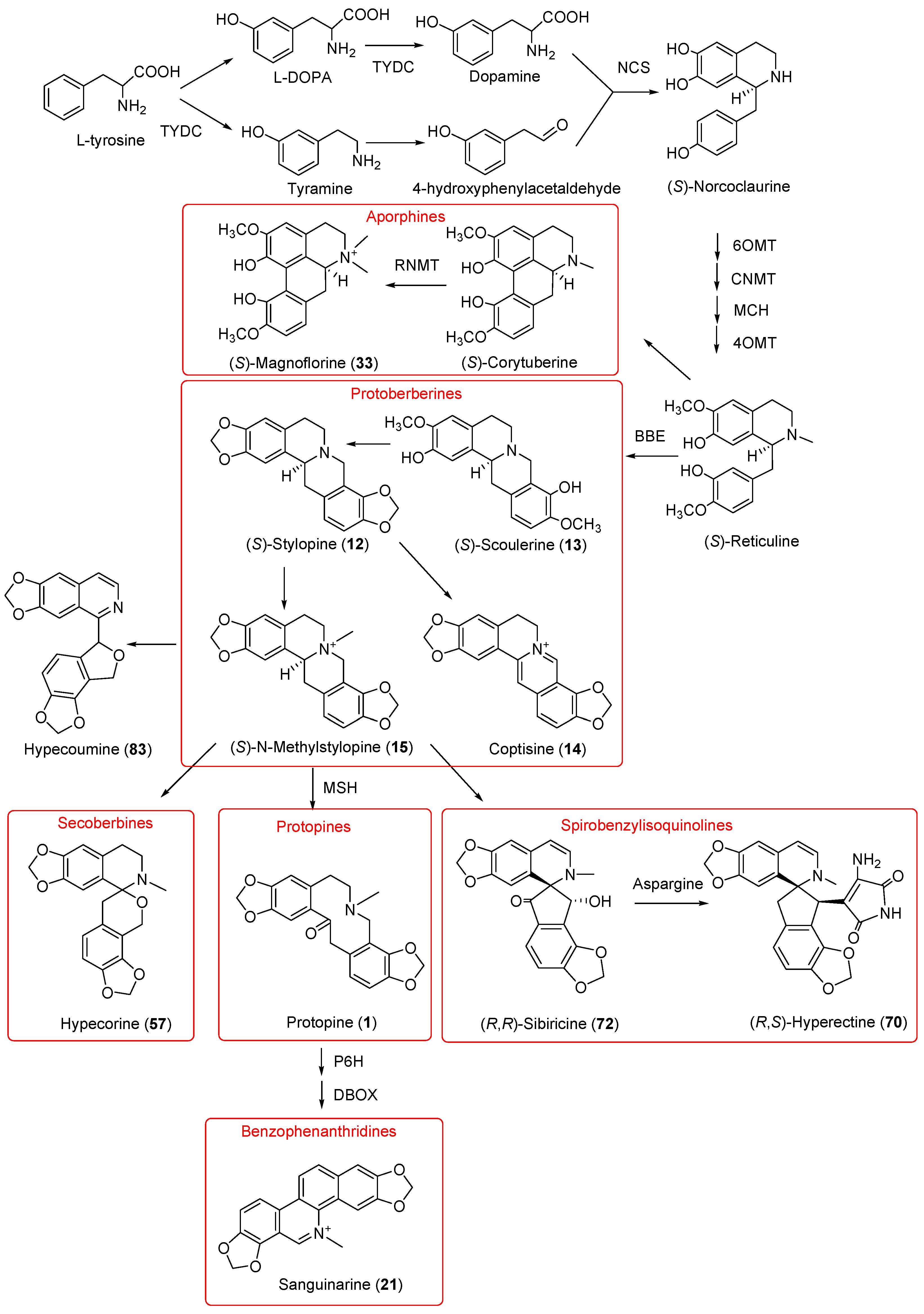
| Accepted Name Species/Subspecies/Ambiguous | Synonym Species/Subspecies/Varieties |
|---|---|
| H. aegypitacum (Forssk.) Asch. & Schweinf. | |
| H. aegyptiacum (Forssk.) Asch. & Schweinf. | H. patens Willd. H. refractum Mart. ex Fedde |
| H. aequilobum Viv | |
| H. angustilobum Å.E.Dahl | |
| H. dimidiatum Delile | |
| H. duriaei Pomel | |
| H. erectum L. | H. millefolium H.Lév. & Vaniot |
| H. imberbe Sibth. & Sm. | |
| H. imberbe Sm | H. procumbens subsp. imberbe (Sm.) Malag. H. glaucescens Guss. H. grandiflorum Benth. H. procumbens subsp. grandiflorum (Benth.) Pau |
| H. lactiflorum (Kar. & Kir.) Pazij | |
| H. leptocarpum Hook.f. & Thomson | H. chinense Franch. H. alpinum Z.X.An |
| H. littorale Wulfen | H. deuteroparviflorum Fedde H. geslini Coss. & Kralik |
| H. pendulum L. | H. tetragonum Bertol. H. caucasicum Koch ex Ledeb. H. ferrugineomaculatum Z.X.An H. pendulum var. parviflorum (Kar. & Kir.) Cullen H. parviflorum Kar. & Kir. |
| H. procumbens L. | H. gracile Benth Cat. H. nodosum Lam. H. armatum Steud. H. ponticum Velen |
| H. procumbens subsp. atropunctatum Å.E.Dahl | |
| H. procumbens subsp. fragrantissimum Å.E.Dahl | |
| H. pseudograndiflorum Petrovic | H. imberbe subsp. pseudograndiflorum (Petrovic) E.Mayer & Nikolic |
| H. torulosum Å.E.Dahl | |
| H. trilobum Trautv. 1 | H. pendulum var. trilobum Cullen |
| H. trullatum Å.E.Dahl | |
| H. zhukanum Lidén |
| Alkaloids/Types | Structure | Species | References |
|---|---|---|---|
| Protopines | |||
| Protopine (1) |  | H. procumbens H. procumbens var. glaucescens H. imberbe H. lactiflorum H. pendulum H. trilobum H. leptocarpum H. erectum H. ponticum H. parviflorum | [2,7,8,9,10,11,12,13,14,15,16,17,18,19,20,21,22,23,24] |
| Dihydroprotopine (2) | 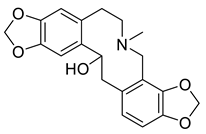 |
H. procumbens H. imberbe H. leptocarpum | [17,24] |
| 13-Oxoprotopine (3) | 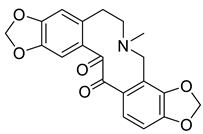 |
H. procumbens H. erectum | [15,19] |
| Cryptopine (4) | 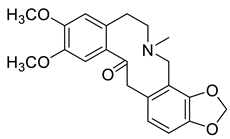 | H. procumbens var. glaucescens H. erectum H. leptocarpum | [2,11,13,19,20,21,22,23,40] |
| Allocryptopine (5) | 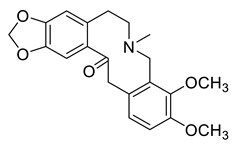 | H. lactiflorum H. leptocarpum H. procumbens H. procumbens var. glaucescens H. erectum | [7,8,10,11,13,14,19,21,40,41] |
| 13-Oxocryptopine (6) | 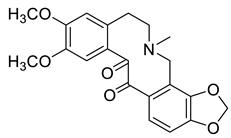 | H. erectum | [19] |
| 13-Oxoallocryptopine (7) |  | H. erectum | [19] |
| Leptocarpine (8) * |  | H. leptocarpum | [42] |
| Hunnemanine (9) | 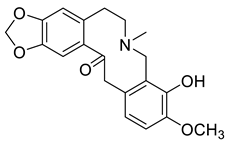 | H. procumbens | [15] |
| Bis[1,3]benzodioxolo[4,5-c:5′,6′-g]azecin-14(4H)-one, 5,6,7,13-tetrahydro-5-methyl-one (10) | 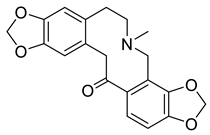 | H. erectum | [19] |
| 6,7,8,14-Tetrahydro-3,4-dimethoxy-6-methylbenzo [c][1,3]benzodioxolo [5,6-g]azecin-15(5H)-one (11) | 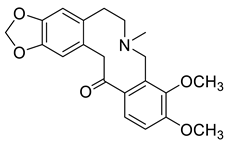 | H. erectum | [19] |
| Protoberberines | |||
| (S)-Stylopine (12) | 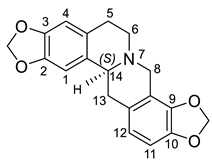 | H. procumbens | [17] |
| (S)-Scoulerine (13) | 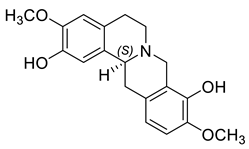 | H. procumbens | [8,15] |
| Coptisine (14) | 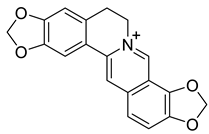 |
H. procumbens H. leptocarpum H. erectum | [8,14,20,23,40,41] |
| (S)-N-Methylstylopine (15) | 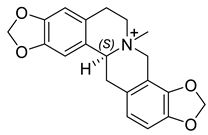 |
H. lactiflorum H. procumbens H. ponticum | [7,17,18] |
| (S)-N-Methylcanadine (16) | 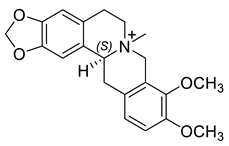 |
H. lactiflorum H. erectum H. procumbens H. ponticum H. leptocarpum | [7,13,17,18,21] |
| Hydroprotopine (17) | 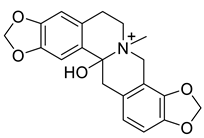 | H. leptocarpum | [27] |
| Benzophenanthridines | |||
| Chelerythrine (18) |  |
H. procumbens H. leptocarpum | [8,14,40] |
| Chelirubine (19) | 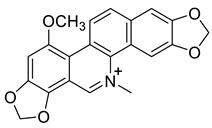 | H. procumbens | [8,14] |
| Dihydrochelirubine (20) | 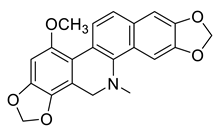 | H. procumbens | [17] |
| Sanguinarine (21) | 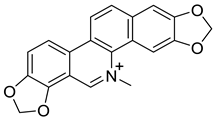 |
H. procumbens H. leptocarpum H. trilobum H. ponticum , H. imberbe | [14,17,18,21,40] |
| Dihydrosanguinarine (22) |  |
H. imberbe H. leptocarpum H. procumbens | [9,10,15] |
| (R,S)-8-Methoxydihydrosanguinarine (23) | 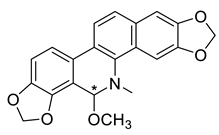 |
H. procumbens H. leptocarpum H. imberbe | [8,9,10] |
| (S)-8-Hydroxymethyldihydrosanguinarine (24) | 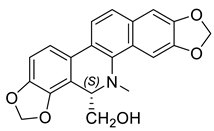 | H. erectum | [19] |
| 8-Acetonyldihydrosanguinarine (25) | 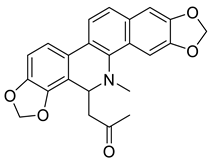 |
H. procumbens H. leptocarpum | [8,10] |
| (R,S)-Nitrotyrasanguinarine (26) |  |
H. imberbe H. pendulum H. procumbens | [9] |
| Oxysanguinarine (27) | 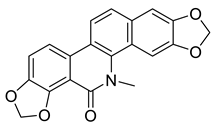 | H. procumbens | [8,15] |
| Norsanguinarine (28) | 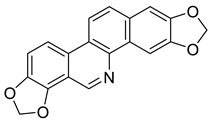 |
H. procumbens H. leptocarpum | [8,15,23] |
| Aporphines | |||
| (S)-Corydine (29) | 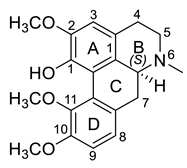 |
H. procumbens H. leptocarpum | [40] |
| (S)-Isocorydine (30) | 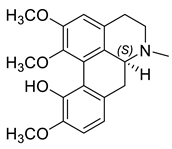 | H. procumbens H. procumbens var. glaucescens H. leptocarpum | [8,11,40] |
| (S)-Bulbocapnine (31) | 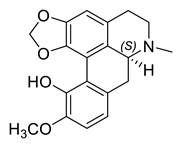 | H. imberbe | [9] |
| (S)-Glaucine (32) | 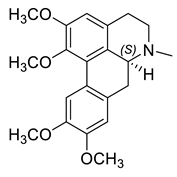 | H. procumbens | [8] |
| (S)-Magnoflorine (33) |  |
H. procumbens H. leptocarpum | [40] |
| Simple isoquinolines | |||
| Oxohydrastinine (34) | 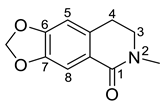 |
H. imberbe H. leptocarpum H. erectum | [2,9,10,12,13,19,21,22,23,24,27] |
| Doryanine (35) |  | H. erectum | [19] |
| N-Methylcorydaldine (36) |  |
H. erectum H. leptocarpum | [13,19,23] |
| 2-Methyl-1,2,3,4-tetrahydro isoquinoline-7-carboxylic acid methyl ester (37) |  | H. erectum | [19] |
| 1,3,6,6-Tetramethyl-5,6,7,8- tetrahydroisoquiolin-8-one (38) |  | H. erectum | [19] |
| Secoberbines | |||
| (S)-Corydalisol (39) |  | H. procumbens | [8] |
| (S)-N-Methylcorydalisol (40) | 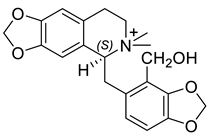 | H. lactiflorum | [7] |
| (S)-Dihydroleptopine (41) (Coryximine) |  | H. leptocarpum | [22,23,43] |
| Hypecocarpinine (42) | 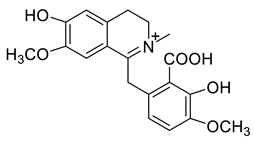 | H. leptocarpum | [24] |
| Hypecocarpine (43) | 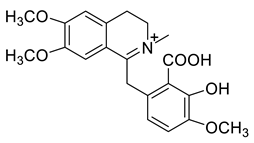 | H. leptocarpum | [27] |
| Leptopinine (44) |  | H. leptocarpum | [12] |
| Leptopine (45) | 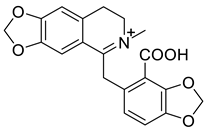 | H. leptocarpum | [12,21] |
| Leptopidine (46) |  | H. leptocarpum | [12,21,22,23,24,27] |
| Hypepontine (47) | 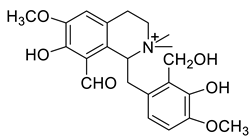 | H. ponticum | [17,18] |
| N-Methylcoryximine (48) | 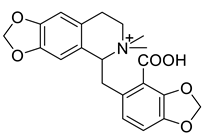 | H. pendulum | [44] |
| Hendersine B (49) | 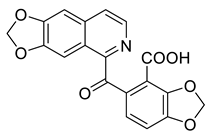 | H. leptocarpum | [23] |
| Procumbine (50) | 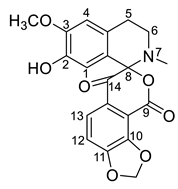 |
H. procumbens H. leptocarpum | [40,45] |
| Leptopidinine (51) | 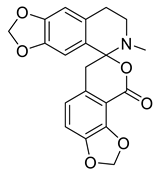 | H. leptocarpum | [12,21,22] |
| Torulosine (52) | 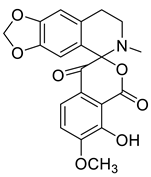 | H. leptocarpum | [23,43] |
| 8-Oxohypecorinine N-oxide (53) | 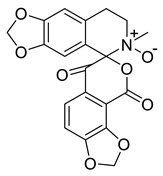 | H. leptocarpum | [43] |
| N-Methyldemethyltorulosine (54) | 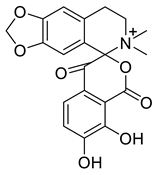 | H. leptocarpum | [23,43] |
| (R,S)-Hypecorinine (55) | 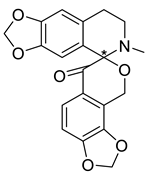 | H. procumbens H. procumbens var. glaucescens H. erectum | [8,11,13,14,19,41,46] |
| (R,S)-8-Oxohypecorinine (56) | 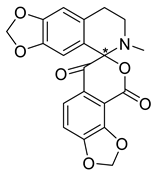 | H. procumbens var. glaucescens | [11] |
| Hypecorine (57) |  | H. erectum | [14,41,46] |
| 2,3-Dimethoxyhypecorinine (58) | 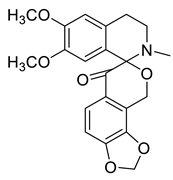 | H. erectum | [19] |
| (S)-Peshawarine (59) | 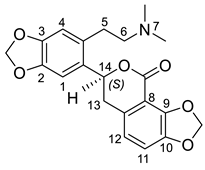 | H. parviflorum | [8,16] |
| Corydamine (60) |  |
H. leptocarpum H. erectum | [10,19,22,23,24,41] |
| Corydamine acid (61) | 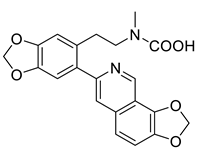 | H. leptocarpum | [23] |
| Leptocaramine (62) (2-(1,3-dioxolo [4,5-h] isoquinolin-7-yl)-4,5-dimethoxy-N-methyl-benzeneethanamine) | 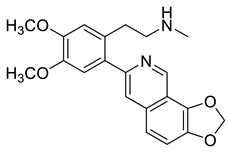 |
H. leptocarpum H. erectum | [19,23,24] |
| N-Formylcorydamine (63) | 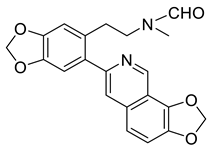 |
H. erectum H. procumbens | [15,19] |
| 2,3-Dimethoxy-N-formyl corydamine (64) | 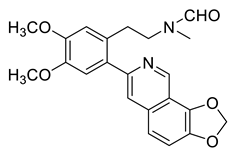 | H. erectum | [19] |
| Hypecumine (65) | 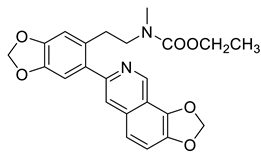 | H. procumbens | [15] |
| 7-N-Methyl-7-N-oxide-2,3-di- methoxycorydamine (66) | 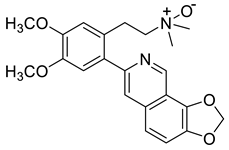 | H. erectum | [19] |
| Spirobenzylisoquinolines | |||
| (S,S)-Hyperectumine B (67) | 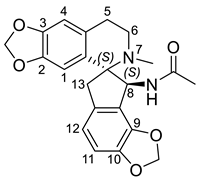 | H. erectum | [19] |
| (S,S)-2,3-Dimethoxyhyperectumine B (68) |  | H. erectum | [19] |
| (R,S) and (S,R)-2,3-Dimethoxyhyperectine (69) | 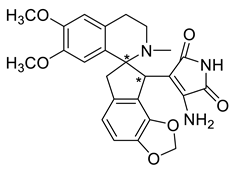 | H. erectum | [19] |
| (R,S) and (S,R)-Hyperectine (70) | 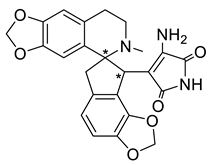 |
H. leptocarpum H. erectum | [10,19,41,46,47] |
| (S,S) and (R,R)-Isohyperectine (71) | 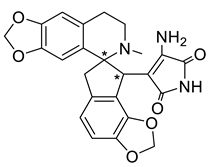 |
H. leptocarpum H. erectum | [10,12,47] |
| (R,R)-Sibiricine (72) | 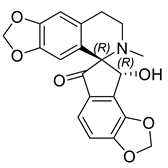 | H. erectum | [19] |
| (R,S)-Hypecoleptopine (73) | 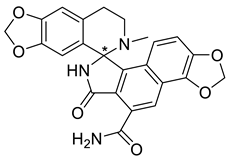 |
H. erectum H. leptocarpum | [21,43,48] |
| Other alkaloids | |||
| (S)-N-Methylcoclaurine (74) | 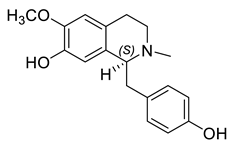 | H. procumbens | [17] |
| N-Methylsecoglaucine (75) |  | H. ponticum | [17,18] |
| (R)-Turkiyenine (76) | 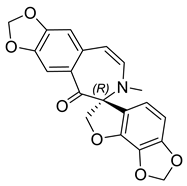 |
H. procumbens H. pendulum H. imberbe | [9,15,49,50] |
| (S)-Oxoturkiyenine (77) | 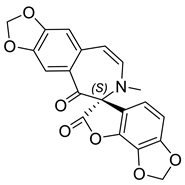 | H. pendulum | [49] |
| Leptocarpinine (78) | 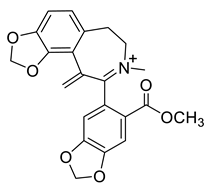 | H. leptocarpum | [12] |
| Leptocarpinine B (79) | 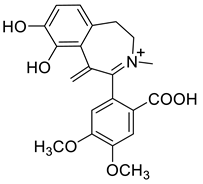 | H. leptocarpum | [23] |
| (S,S)-Trans-benzindenoazepines (80) | 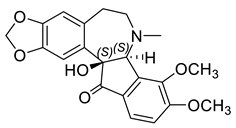 | H. erectum | [19] |
| (S,S)-O-Methylfumarostelline (81) | 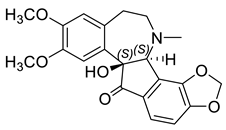 | H. erectum | [19] |
| Leptocarpine (82) * | 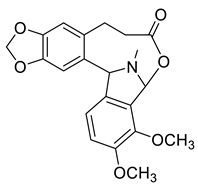 | H. leptocarpum | [10,22] |
| Hypecoumine (83) | 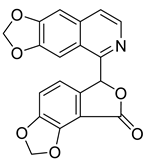 | H. procumbens | [2] |
| Hyperectumine (84) (8S, 9R, 15R) (8R, 9S, 15S) | 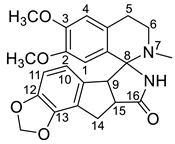 | H. erectum | [25] |
| Dibenzooxazacycloundecine (85) | 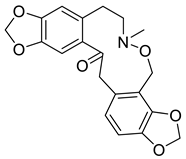 | H. erectum | [19] |
| Hypeisoxazole A (86) (6S, 8R, 14R) (6R, 8S, 14S) |  | H. erectum | [48] |
Disclaimer/Publisher’s Note: The statements, opinions and data contained in all publications are solely those of the individual author(s) and contributor(s) and not of MDPI and/or the editor(s). MDPI and/or the editor(s) disclaim responsibility for any injury to people or property resulting from any ideas, methods, instructions or products referred to in the content. |
© 2023 by the authors. Licensee MDPI, Basel, Switzerland. This article is an open access article distributed under the terms and conditions of the Creative Commons Attribution (CC BY) license (https://creativecommons.org/licenses/by/4.0/).
Share and Cite
Kostova, N.; Doncheva, T. Hypecoum spp.—Chemistry and Biological Activity of Alkaloids. Diversity 2023, 15, 1023. https://doi.org/10.3390/d15091023
Kostova N, Doncheva T. Hypecoum spp.—Chemistry and Biological Activity of Alkaloids. Diversity. 2023; 15(9):1023. https://doi.org/10.3390/d15091023
Chicago/Turabian StyleKostova, Nadezhda, and Tsvetelina Doncheva. 2023. "Hypecoum spp.—Chemistry and Biological Activity of Alkaloids" Diversity 15, no. 9: 1023. https://doi.org/10.3390/d15091023
APA StyleKostova, N., & Doncheva, T. (2023). Hypecoum spp.—Chemistry and Biological Activity of Alkaloids. Diversity, 15(9), 1023. https://doi.org/10.3390/d15091023








